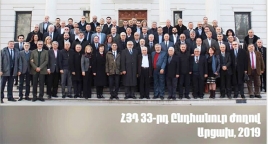ARF Signals Return to Roots By Passing Women’s Quota at World Congress
Monday, February 4, 2019
BY HAIG KAYSERIAN
We are quick to criticise political parties in the Armenian world, which is always expected and often justified. However, it is very important we praise the good they do, when they do it. And “good” is an understatement when referring to the groundbreaking gender quota resolution that recently passed at the Armenian Revolutionary Federation World Congress.
The party’s 33rd World Congress, which brought together 100 delegates and guests from over 30 countries to Artsakh in January 2019, recognized that more needed to be done to ensure greater female representation in the Pan-Armenian party’s decision-making processes.
The ARF World Congress is the highest authority of the 128-year-old political party, and only eight of the 100 in attendance were female. While this number was considerably higher than the 2015 version of this meeting, it was still considered unacceptable by the majority who were in attendance.
The fact that the ARF has never elected a woman to its Bureau is also unacceptable, especially considering this is the party that led one of the most gender progressive governments in the world. The First Republic of Armenia (1918-1921) elected three females as Members of Parliament, which was decades before much of the rest of the world, who at the time were debating whether to allow women the right to vote.
Many resolutions that were adopted at the 33rd World Congress symbolized the party’s readiness to return to its progressive roots, but none more so than this gender quota, which ensures the ARF becomes the first modern Armenian political party to adopt any sort of internal regulation that will significantly promote women to positions of leadership.
The ARF resolved that, henceforth, all decision-making meetings (AGMs, Regional Conventions and World Congress) and bodies (Committees [Կոմիտէ], Central Committees [Կեդրոնական Կոմիտէ] and Bureau [Բիւրոյ]) must elect female delegates and members at a percentage proportionate with the representation of females in the respective meeting’s or body’s jurisdiction.
For example, if a region (Կեդրոնական Կոմիտէութիւն) is made up of 20 percent females, 20 percent of their Regional Convention (Շրջանային Ժողով) and 20 percent of their Central Committee (Կեդրոնական Կոմիտէ) needs to be female. This needs to be replicated at all levels.
Further, the resolution stipulates that the next World Congress must set a universal gender quota that will be applied across the board (for example, if that is set at 25 percent, then a minimum of 25 percent of all ARF decision-making meetings and bodies will be female, regardless of region).
The only reason that a universally applicable quota was unable to be adopted at this meeting was because some regions exist where women make up a very small percentage of the total membership. The stipulation on the next World Congress to adopt a universal quota means these regions have three years to increase the percentage of women party members.
To give some sort of an idea of what the ARF has to look forward to, it is a worthwhile exercise to hypothetically (and retrospectively) apply this gender quota to the most recent meeting. Had this resolution been passed before the 33rd World Congress, female attendance would have approximately been a minimum of 20 percent, which is more than double the 8 percent that were in attendance in Stepanakert. Further, an ARF Bureau would have been elected with at least three women in body of 13.
And this is based on today’s numbers, which show that 20 percent of the global ARF membership is made up of women. With effort and trust from all sides, this historic gender quota should increase the number of women who join the party, and the 20 percent could therefore increase in time for the next World Congress. This is the party’s challenge for the forthcoming three years.
A challenge that should be made easier once a series of other resolutions adopted at the 33rd World Congress become known to the public. The ARF remains resilient on the right to self-determination of the Republic of Artsakh and on justice for the Armenian Genocide, but has also re-committed itself to its grassroots, to its people.
The ARF, which is currently not represented in the Republic of Armenia’s National Assembly, adopted a bold strategy that will return its focus to the grassroots in an effort to become a viable alternative parliamentary force in the future. The ARF will stand for the rights of the worker, the retiring and the retired, the woman, the child, the soldier, the student … the citizen, the small business, and the environment. In short, the ARF resolved to double down on its progressive roots, which have helped make it the most successful Pan-Armenian political organisation.
Haig Kayserian is the Executive Director of the Armenian National Committee of Australia, with a Bachelors in Media & Cultural Studies (Macquarie University) and is currently completing his Masters in Politics & Policy (Deakin University). He is a Director at several technology companies based in the United States and Australia, and is an Advisory Board member at Armenia’s first technology venture capital firm.
http://asbarez.com/177539/arf-signals-return-to-roots-by-passing-womens-quota-at-world-congress/





